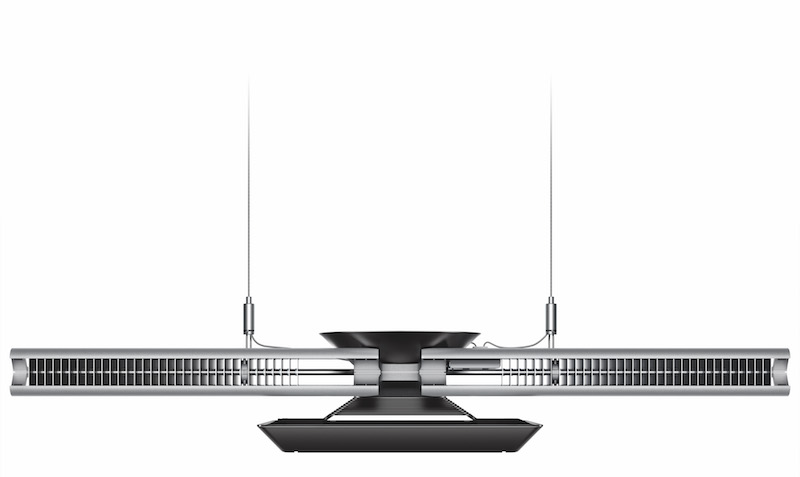Dyson is mostly known for its (expensive) vacuum cleaners that claim to never lose suction and have the ability to get every inch of your carpet clean, but Dyson’s newest invention isn’t a new super powerful or ultra quiet vacuum cleaner, in fact, it isn’t a vacuum cleaner at all; it’s the Cu-Beam Duo, a light that is rated to operate for 22 years without a bulb change.
As Fastcodesign.com reports, the Cu-Beam Duo is a new lighting system that uses just two LEDs, not the hundreds that most commercial lighting fixtures use, to light the space below the fixture, above the fixture, or a combination of the two. Each LED is about the size of a quarter, massive for LED standards, and is fitted with custom-engineered lenses to spread the glow over a larger area. One LED provides the light for task surfaces below while the other provides the ceiling light, which is optimal for illuminating open spaces like atriums, or offices.
The actual lights make up just a small portion of the 28-inch fixture, however. The rest is a large heat sink with the sole purpose of keeping the LEDs cool because a cool LED can run for a very long time without fading or discoloring. The Cu-Beam Duo uses heat pipe technology to cool the two LEDs.

The Cu-Beam Duo uses six vacuum-sealed heat pipes to transfer heat away from the light source to be dissipated along the wings. Each tube contains a drop of water. When the light is turned on, the heat turns the water into vapor. The vapor then disperses throughout the pipe and, when it reaches a cool area of the tube, condenses back into water. A copper wick then draws the water back toward the heat source and the process starts again.
The idea to cool LEDs with a heat pipe was first used in the CSYS desk lamp, a lamp that came with the promise of running for 40 or 50 years without needing to change the bulb. The Cu-Beam Duo takes this initial technology and improves and expands upon it.
The stock light puts out 8,500 lumens but it can be changed and fitted with a 20,000 lumen LED. Additionally, there are sensors that can detect when no one is at the table or workspace below and shut off the down light, leaving just the up beam on to keep the room illuminated. Additionally, the each lamp has internal shutters that can crop the down beam to the width of the table below with no spill. The crop light is not wasted, though. The Cu-Beam Duo uses "Ricochet" technology to convert any unwanted down light into up light.
The Cu-Beam Duo has not been priced yet, but the company says it was designed with the intention of being used for large-scale, commercial products. The lights will be available in silver, black, and white with Dyson offering a range of custom colors, as well.
Related Stories
| Mar 1, 2012
8 tips for architects to consider before LED installation
Lighting experts offer Building Team members critical information to consider before upgrading lighting systems to LEDs.
| Feb 28, 2012
LUMEnergi names Weinbaum president and CEO
Weinbaum’s experience spans communications, nanotechnology, electronics components, consumer products, semiconductors, software, wireless and lighting.
| Jan 24, 2012
U of M installs new lighting at Crisler Player Development Center
Energy efficient lighting installed at PDC reduce costs and improves player performance.
| Jan 9, 2012
Lutron appoints Pessina president
In his 35-year career with Lutron, Pessina has acquired broad experience in the engineering, quality assurance and manufacturing areas.
| Dec 13, 2011
Lutron’s Commercial Experience Center awarded LEED Gold
LEED certification of the Lutron facility was based on a number of green design and construction features that positively impact the project itself and the broader community. These features include: optimization of energy performance through the use of lighting power, lighting controls and HVAC, plus the use of daylight.
| Nov 23, 2011
Griffin Electric completes Gwinnett Tech project
Accommodating up to 3,000 students annually beginning this fall, the 78,000-sf, three-story facility consists of thirteen classrooms and twelve high-tech laboratories, in addition to several lecture halls and faculty offices.
| Nov 17, 2011
Campus-wide energy-efficiency program aims to deliver $3.5 million in energy and operational savings
Merced College and Honeywell will use the school’s energy usage statistics to develop a course curriculum on sustainability, and raise awareness among students of the positive impact conservation practices contribute to the community.
| Oct 17, 2011
Schneider Electric introduces UL924 emergency lighting control devices
The emergency lighting control devices require fewer maintenance costs and testing requirements than backup batteries because they comply with the UL924 standard, reducing installation time.
| Oct 14, 2011
MaxLite receives 2011 Lighting for Tomorrow honorable mention
The judging panel was particularly impressed with the performance of this fixture.

















